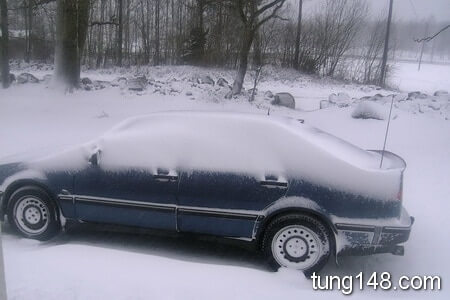Winter is a tough time of year where vehicles are concerned. Iced windshields, frozen locks, and getting stuck in mud and snow are all too common winter automotive realities. Follow these simple tips and tricks to make winter driving life a little easier.
Warming Up

Windows
Ice covered windows are not only a pain, they are unsafe. Prevent ice from covering your windshields during a storm with these tricks. Put a large, flattened piece of cardboard or the floor mats from your car over the windshield, securing them under the wipers when parking during a storm. When it’s time to leave again, gently crack the wipers free and remove the covering; your windshield will be clear and ice-free, without any scraping. Large garbage bags taped together and laid across the windshield, closed in the doors, protects from ice build ups, too.
We’ve all had it happen: the missing ice scraper. In the absence of this important tool, try using a nylon or plastic kitchen spatula or the edge of a credit card.
To help loosen and melt away a solid or hard-frozen sheet of windshield ice, keep a box of fine grain salt in the car. Pour the salt over the ice and rub it in. Give it a few minutes to work, then scrape the ice away.
How many times have you run out of windshield washer fluid and forgotten to buy more? This winter, try this home-made washer solution. Combine two quarts of rubbing alcohol, one cup water, and one teaspoon dish detergent. With the alcohol, the mixture should be safe to a freezing point of thirty degrees below zero (Fahrenheit).
Frozen Locks
Eventually, a frozen set of locks hits everyone. Small cans of lock deicer are sold commercially, but these tricks work as well.
Warm the key with a match or lighter, then try thawing your way into the frozen lock; or, try putting the key in as far as it will go, then burn a piece of twisted paper near the frozen lock and key.
A heat liniment (like those used to calm sore muscles) squirted into the keyhole may warm it enough to free the lock.
Of course, your best bet is prevention, and here’s a simple tip: when you lock the car, cover the locks with thin magnet strips. Remove them when you return for frost-free locks, ready to go.
Cleaning and Washing
To get the salt to come out of carpets and floor mats, wash them with a solution of one part vinegar and two parts water. The vinegar should break down the salty residue.
Of course, again prevention is best when it comes to rust. Try to prevent salt build ups and resulting rust with frequent trips to the car wash.
For an at home solution to remove the salt and mud from your undercarriage, try this on warm winter days or when the worst is over. Place a short lawn sprinkler underneath the car and run it for half an hour.
Batteries
It’s a good idea to replace an older battery before it gives you cold weather trouble, but just in case, if your battery is old or questionable, remove it and take it into a warm house or garage at night when the temperature is expected to drop very low. Be careful where you leave it, batteries are filled with acid that can corrode surfaces. Battery contents are flammable; keep them away from flames and heat sources.
If your don’t want to mess with removing a battery, or you’re not sure your battery is that bad, back your vehicle into its parking space or the garage so it can be reached with jumper cables if the car decides not to start.
Getting Stuck
We may not like to admit it, but getting stuck in winter ice and snow happens to most of us eventually. Having something to put down for traction can usually get you out if gently rocking the car doesn’t work. For a backup, keep a couple of asphalt roof shingles in your trunk. Other emergency traction suggestions: carry coffee cans filled with salt and sand, boards, a sheet of canvas, or an old rubber bathmat cut in half lengthwise. In a pinch you can use tree branches or your interior floor mats for traction, too.
It should probably go without saying, but having your vehicle checked ahead of time can prevent many winter driving problems. Do it yourself or hire a professional to check all your fluids, wires, and plugs, including washer fluid and very importantly, the radiator’s antifreeze. Check tires for traction and proper inflation. Make an emergency kit and put together extra lock deicer, washer fluid, jumper cables, cones, markers or flairs, and carry a blanket, snack foods, and water just in case you get stuck somewhere for a while.
Use these handy hints to make your winter driving life a little easier, and be prepared for the inevitable unexpected winter obstacles.
Thanks: Ellen Russell (http://www.doityourself.com/stry/winterdrivingtips#ixzz16aVOB881)





















